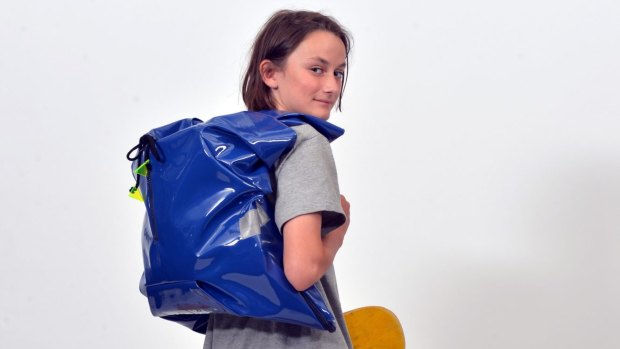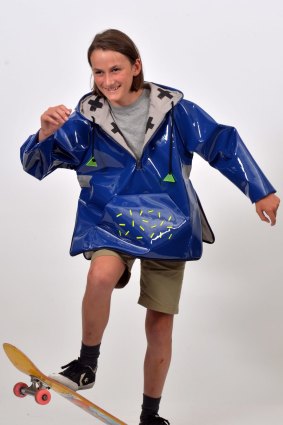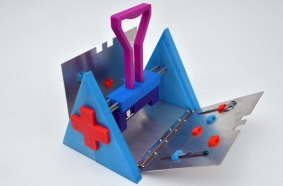This was published 7 years ago
Is VCE failing our top design students?
The annual Top Designs exhibition celebrates kids with a flair for design. Which is just as well, because they're already at a disadvantage.
By Ray Edgar
Melbourne Museum's annual Top Designs exhibition celebrates the kids who ignore the sceptics. Where many students opt for traditional subjects that will get them a high VCE rank, these 90 students typically risk a lesser outcome in order to fulfil their passion.
Textile designer Sophia Loughrey's PVC jacket transforms into a backpack that's warm, waterproof and hi-vis. Zac Berra designed a medical product for field surgeons to transport and sterilise their instruments.

Top Designs' Sophia Loughrey's jacket/backpack.
Despite the commitment, prestige and vindication of being in Top Designs, both Loughrey and Berra received ATAR (Australian Tertiary Admissions Rank) scores scaled down by seven points.
It seems the ranking system still treats design as though it were a bludge.

Top Designs' Sophia Loughrey's jacket/backpack.
"After Year 12 – and seeing the amount of work that people put into folios – that view of it as a 'bludge subject' does change," says Berra. But his peers were "shying away from design because they don't want the time and effort they put into the subject for the reward they get out of it at the end of the year".
Educators such as Jill Livett, vice president of DATTA Vic (Design and Technology Teachers' association) and co-author of the main textbook for VCE design subjects, believes scaling down is one of the reasons there has been a flight from design subjects. In the past five years, there has been a 25 per cent drop in VCE enrolment numbers for Product Design and Technology, with a further 25 per cent dropping the subject in Year 12.
"They're not supposed to be easier subjects," says Livett. "They're written to have the same educational rigour. The workload for subjects is really high, yet it gets marked down. So the effort is not recognised or valued."
These concerns are shared by tertiary institutions such as Monash University.

Zac Berra's Total Instrument Management System is on show as part of Top Designs.
"We're feeling the impact of students not choosing the creative units in high schools," says Dr Gene Bawden, deputy head of design at Monash University. "If the same dwindling occurs we'll be scratching to fill our programs in 10 years."
What happens to the development of Victoria as a design state? The Victorian Design Initiatives program of 2012-15 boasts that more than 185,000 people are employed in the Victorian design sector, contributing around $7 billion annually to the state's economy and drawing more than $300 million in design-related exports. It seems odd, then, that we don't encourage students to pursue design.
The Australian government's push for STEM (science technology engineering and maths) subjects is part of the issue. "We also need to value the design skills and the application in engineering," says Livett. "That's often when the innovation comes through – when you're apply the design and engineering part of the STEM."
Zac Berra understands how useful design can be. With his sights set on aerospace engineering, he chose product design and technology in order to round out his studies in maths and science. He was accepted to the UNSW Canberra, but he was disappointed that his work was marked down.
"I didn't want to just be a 'calculator'," he says. "Design definitely helped me in my thinking, and planning how to solve a problem, how to think outside the box and brainstorm different ideas."
Design skills have wider application, says Professor Scott Thompson-Whiteside, executive dean Faculty of Health, Arts and Design at Swinburne University. He believes design should be taught throughout school.
"I would honestly want design to be a mandatory subject in all schools," says Whiteside. "It's such a critical component of being an innovative nation. There are a whole load of implicit learning skills that go on with design education at school level. [Design] requires forward planning, project management and communication skills and visual communication."
Part of the problem is people don't fully understand what design is, or the job opportunities – even among career guidance teachers.
Bawden agrees. "There are growing rather than diminishing opportunities in design," he says. "Ten years ago design was two things: graphic design or industrial design. Now the technology that spans all disciplines makes it a less obvious defined space."
The ubiquitous yet high-tech world of interaction or UX – user experience – design is perhaps the field's most burgeoning area.
Outlining design opportunities drives Design Futures. For the past 12 years, the annual event organised by the agIdeas Design Foundation has been hosting speakers from across a range of fields, from more traditional communications to digital architecture, virtual reality gaming, video special effects and experience design.
"Our aim has been to encourage bright students into the design field," says organiser Kristin McCourtie. "The program is also valuable for parents who may feel compelled to push strong students into more known traditional fields such as law or medicine. It helps them to appreciate that there are real career opportunities for their children in these industries."
Design Futures Forum and Career Expo, May 31, ideasondesign.net
Top Designs, Melbourne Museum until July 10; museumvictoria.com.au